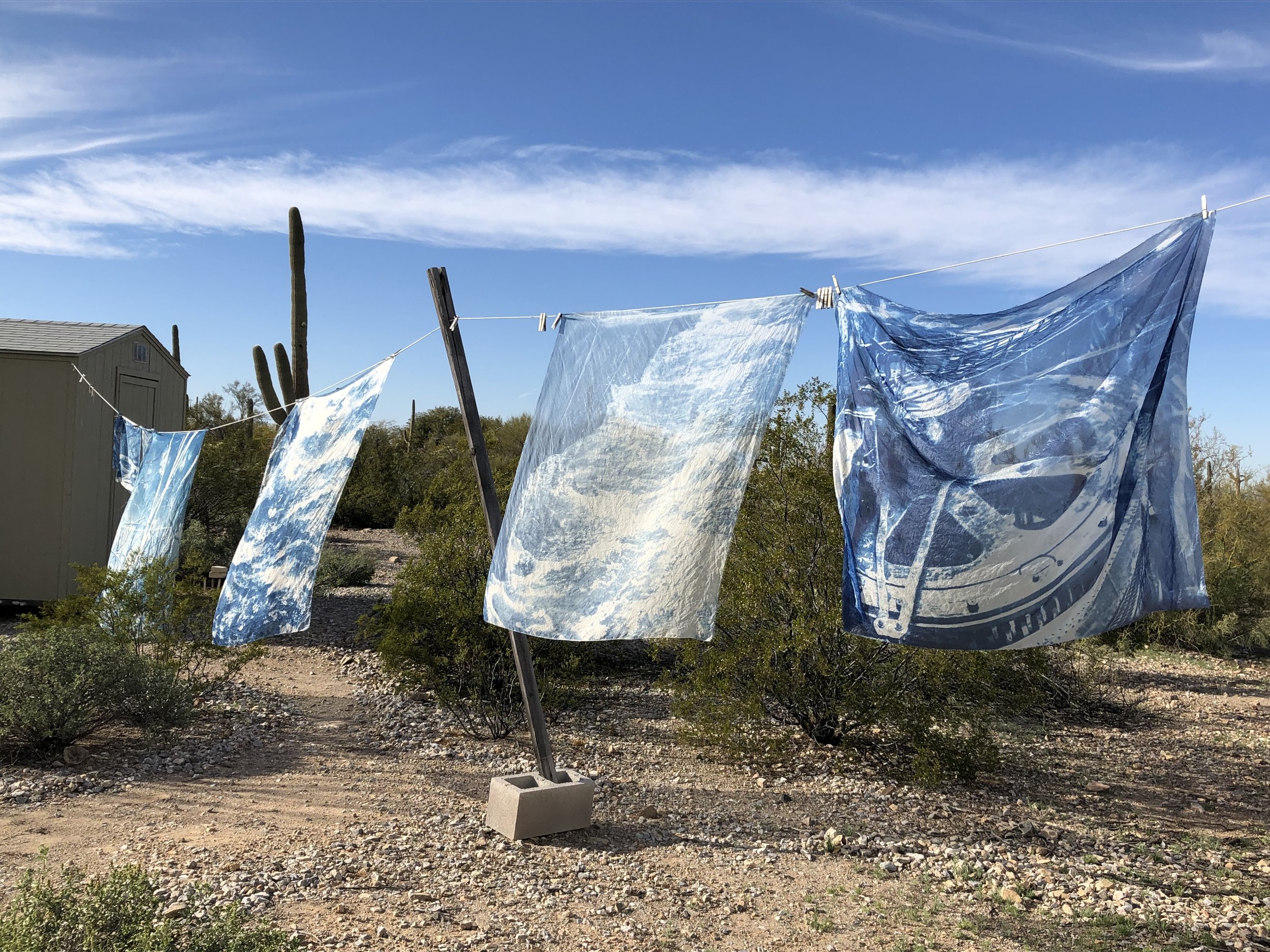Natural Consequences- Embracing Ambiguity
‘Natural Consequences,’ an installation, explores our tendency and need to interpret our surroundings to reconcile our relationship between the natural world, with its own laws and trajectories, and our industrial human-constructed world. This piece, composed of numerous panels of transparent silk organza, each 48 inches high and between 60 and 96 inches long, can be up to 25 feet long and can be reconfigured to different lengths. It is suspended in such a way as to allow for overlap of the panels. Additionally, photographs of the sheer cyanotypes in the environment provide context.
Multiple large panels of transparent silk organza are printed using Cyanotype, a primitive photographic process that embraces nature’s unpredictability and allows both choice and chance to factor into the outcome of each panel.
Large negatives were placed onto sheer silk organza fabric that had been coated with cyanotype chemicals, and exposed in the sun.
The exposed fabric was developed and rinsed with water, in shade, using my patented “3-bucket method.”
Cyanotype is just about the most eco-friendly photographic process there is, no harm came to this glorious desert landscape.
Watching the cyanotypes billow as they dried in the breeze was mesmerizing, leading me to look for ways to recreate this feeling “in captivity” so to speak, indoors in a gallery setting.
The resulting blue images, delicate and transparent, are overlapped, conjuring recognition, juxtaposition, blending, new synthesis, and deeper understanding. Images from our collective memories, such as nature, industry and natural disaster, exist together, bringing forth ideas of nature’s power and resilience. Photographs of the panels existing within the landscape, billowing with the wind and affected by the elements invite a conversation with the landscape that surrounds the piece, and the delicate balance of its stability and its disequilibrium. There is an erosion of narrative through the obscuring of one image with the overlap of another; nothing is clear, straightforward, or easy. Multiple realities coexist, and distinct facts, locations, paradigms or viewpoints begin to be inextricable from their counterpoints. Observing the analytical process, left with the flow, results in an awareness that perception is nuanced, fluid and shifting, grounded in historical context, and continually shaped new by information. Life itself is an ongoing collage, drawing from a reservoir of memory, interpretation, imagination.
Our senses are bombarded by stimuli, and our brains work to knit disparate elements together, filtered through historical context into one continuing story. When facing complex problems and situations, whether personal or global, reaching beyond the obvious allows us to see how disparate realms that are at odds with one another are inextricably intertwined. Our capacity for discernment can take us beyond simple observation toward novel ideas and creative solutions that may help us restore balance between them. Ambiguity is a way to perceive connectedness, understand varying perspectives and imagine alternative possibilities. Creativity in the face of adversity generates resilience.
About cyanotype-
Cyanotype is an antique photographic process distinctive for its Prussian blue monochrome prints. It was invented by English scientist and astronomer Sir John Herschel in 1842. A year later, Anna Atkins, an amateur scientist, used the process to create a limited series of cyanotype books that documented ferns and other plant life; she is regarded as the first person to publish a book of photographs. As photography improved, cyanotype fell out of favor, surviving as a copying technique for documents and plans in the form of blueprints. Fascination with early or alternative photographic techniques has led to a renewed interest in cyanotype, as it is easy to master and eco-friendly. The chemicals can be applied to a variety of surfaces and exposed in contact with an object or negative either directly to the sun or to an artificial ultra violet light source. Development simply involves washing with water and allowing to dry naturally.




